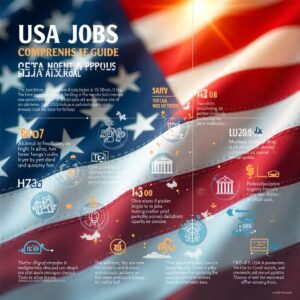Introduction
In today’s competitive job market, securing a position in the United States can be both an exciting and daunting task. With the rise of technology and the evolving landscape of industries, the way we search for jobs has transformed significantly. This detailed blog post aims to provide a comprehensive guide to “USA jobs,” covering various aspects including job search strategies, resources, industries in demand, and frequently asked questions (FAQs) to equip you with the knowledge needed for your job hunt.

Table of Contents
- Understanding the Job Market in the USA
- Overview of the US Job Market
- Key Industries in Demand
- Current Employment Trends
- Effective Job Search Strategies
- Online Job Portals
- Networking
- Resume and Cover Letter Tips
- Leveraging Social Media
- Resources for Job Seekers
- Government Resources
- Non-Profit Organizations
- Job Fairs and Recruitments
- Professional Associations
- Navigating Job Applications
- How to Apply for Jobs
- Preparing for Interviews
- Following Up After Interviews
- Salary Negotiation Tips
- Understanding Employment Laws and Rights
- Overview of Employment Laws
- Workers’ Rights and Protections
- FAQs about USA Jobs
- Common Questions and Answers
- Conclusion
1. Understanding the Job Market in the USA
Overview of the US Job Market
The US job market is vast and diverse, offering a wide range of opportunities across different sectors. As of [insert relevant date], the unemployment rate stands at [insert current unemployment rate], indicating a recovering economy post-pandemic. According to the Bureau of Labor Statistics (BLS), the job market is projected to grow by [insert percentage] over the next decade, driven by advancements in technology and shifts in consumer behavior.
The job market is influenced by various factors, including economic conditions, technological advancements, and demographic changes. Understanding these factors can help job seekers make informed decisions about their career paths.
Key Industries in Demand
- Healthcare: With an aging population, the demand for healthcare professionals continues to rise. Jobs in nursing, therapy, and medical technology are particularly sought after. The BLS projects that healthcare occupations will grow by [insert percentage] from [insert year] to [insert year].
- Technology: The tech industry is booming, with roles in software development, data analysis, and cybersecurity in high demand. The digital transformation across industries has created a continuous need for tech-savvy professionals.
- Renewable Energy: As the world shifts towards sustainable practices, jobs in renewable energy, such as solar and wind energy, are on the rise. The renewable energy sector is expected to grow significantly as more companies and governments commit to reducing carbon emissions.
- Education: The education sector remains a stable source of employment, with a consistent need for teachers, administrators, and support staff. The demand for qualified educators is particularly high in underserved areas.
- Logistics and Transportation: The growth of e-commerce has led to an increased demand for logistics and transportation professionals. Roles in supply chain management, warehousing, and delivery services are crucial for maintaining the flow of goods.

Current Employment Trends
The job market is continually evolving, and staying informed about current trends is essential for job seekers. Some notable trends include:
- Remote Work: The pandemic has accelerated the adoption of remote work, with many companies now offering flexible work arrangements. Job seekers should consider opportunities that allow for remote or hybrid work.
- Gig Economy: Freelancing and gig work are becoming more prevalent as individuals seek flexible employment options. Platforms like Upwork and Fiverr provide opportunities for freelancers across various fields.
- Skill-Based Hiring: Employers are increasingly focusing on skills rather than formal education. Job seekers should highlight relevant skills and certifications to stand out.
2. Effective Job Search Strategies
Online Job Portals
One of the most effective ways to find USA jobs is through online job portals. Websites like:
- Indeed: A comprehensive job search engine that aggregates listings from various sources. It allows users to upload resumes and apply directly through the site.
- LinkedIn: A professional networking site that also features job postings and allows you to network with industry professionals. Regularly updating your profile can attract potential employers.
- Glassdoor: Offers job listings along with company reviews and salary information. This transparency can help job seekers evaluate potential employers.
- Monster: A long-standing job portal that provides job listings, resume services, and career advice.
- SimplyHired: Another job search engine that aggregates listings and provides salary information for various positions.
Networking
Networking is crucial in today’s job market. Attend industry events, join professional associations, and utilize social media platforms to connect with potential employers and fellow job seekers. Personal connections can often lead to job opportunities that aren’t advertised publicly.
- Attend Job Fairs: Job fairs provide an opportunity to meet multiple employers in one location. Prepare your elevator pitch and bring copies of your resume.
- Join Professional Associations: Many industries have associations that offer networking events, resources, and job boards exclusive to members.
- Utilize Informational Interviews: Reach out to professionals in your desired field and request informational interviews to learn about their career paths and seek advice.
Resume and Cover Letter Tips
Your resume and cover letter are your first impressions on potential employers. Here are some tips:
- Tailor Your Resume: Customize your resume for each job application, highlighting relevant experience and skills. Use keywords from the job description to pass through Applicant Tracking Systems (ATS).
- Professional Format: Use a clean, professional format that is easy to read. Avoid using overly complex designs that may confuse ATS.
- Strong Cover Letter: Write a compelling cover letter that explains why you are a good fit for the position and the organization. Share specific examples of your accomplishments and how they relate to the job.
Leveraging Social Media
Social media can be a powerful tool for job seekers. Here are some tips for using platforms like LinkedIn effectively:
- Optimize Your Profile: Ensure your LinkedIn profile is complete, including a professional photo, a compelling headline, and a summary that highlights your skills and experiences.
- Engage with Content: Share articles, comment on posts, and engage with industry leaders to increase your visibility.
- Join Groups: Participate in LinkedIn groups related to your industry to connect with like-minded professionals and discover job opportunities.

3. Resources for Job Seekers
Government Resources
The U.S. government offers various resources for job seekers, including:
- USAJOBS: The federal government’s official employment site, where you can find job listings for federal positions. It provides detailed information about job requirements and application processes.
- CareerOneStop: Sponsored by the U.S. Department of Labor, this site provides tools for job searching, resume writing, and interview preparation. It also offers information on training and education programs.
- State Employment Agencies: Each state has its own employment agency that provides job listings, resources, and support for job seekers.
Non-Profit Organizations
Many non-profit organizations provide job placement services and resources for job seekers, particularly for underrepresented groups. Examples include:
- Goodwill Industries: Offers job training and placement services, as well as career counseling.
- Dress for Success: Provides professional attire and career development services for women entering the workforce.
- The Urban League: Focuses on economic development and job training for African Americans and other underserved communities.
Job Fairs and Recruitments
Job fairs are excellent opportunities to meet potential employers in person, learn about job openings, and network with other job seekers. Check local community centers, universities, and online event platforms for upcoming job fairs.
- University Career Centers: Many universities host job fairs for students and alumni, providing access to employers looking for entry-level candidates.
- Industry-Specific Events: Look for job fairs tailored to specific industries, such as technology, healthcare, or education.
Professional Associations
Joining a professional association related to your field can provide access to job boards, networking events, and industry-specific resources. Many associations also offer certification programs that can enhance your qualifications.
4. Navigating Job Applications
How to Apply for Jobs
When applying for jobs, follow these steps:
- Research the Company: Understand the company’s culture, values, and mission. Tailor your application to align with their goals.
- Follow Application Instructions: Ensure you follow the application guidelines specified in the job listing. This includes submitting required documents and adhering to deadlines.
- Submit Your Application: Submit your application through the specified channels, whether it’s online or via email. Keep track of your applications and follow up as necessary.
Preparing for Interviews
Preparation is key to a successful interview:
- Practice Common Interview Questions: Prepare answers to common interview questions and practice with a friend or mentor. Focus on behavioral questions that assess your problem-solving and teamwork skills.
- Dress Appropriately: Choose professional attire that aligns with the company culture. Research the company’s dress code to ensure you make a good impression.
- Be Punctual: Arrive on time, or log in early for virtual interviews. Being punctual demonstrates professionalism and respect for the interviewer’s time.
Following Up After Interviews
After an interview, sending a thank-you email is a courteous gesture that can set you apart from other candidates. Express your appreciation for the opportunity, reiterate your interest in the position, and mention any key points discussed during the interview.
Salary Negotiation Tips
Negotiating your salary can be intimidating but is an essential part of the job application process. Here are some tips:
- Know Your Worth: Research industry standards for salaries in your field and geographic location. Websites like Glassdoor and PayScale can provide valuable insights.
- Be Prepared to Discuss: When asked about salary expectations, provide a range based on your research and experience. Be confident in your value.
- Consider the Entire Package: In addition to salary, consider benefits such as health insurance, retirement plans, and work-life balance when evaluating job offers.

5. Understanding Employment Laws and Rights
Overview of Employment Laws
Understanding employment laws is crucial for job seekers and employees. Key laws include:
- Fair Labor Standards Act (FLSA): Establishes minimum wage, overtime pay, and child labor standards.
- Equal Employment Opportunity Commission (EEOC): Enforces laws against employment discrimination based on race, color, religion, sex, national origin, age, disability, and genetic information.
- Occupational Safety and Health Administration (OSHA): Ensures safe and healthy working conditions by setting and enforcing standards.
Workers’ Rights and Protections
Employees have various rights and protections under federal and state laws, including:
- Right to Fair Pay: Employees are entitled to receive at least the minimum wage and overtime pay for hours worked over 40 in a workweek.
- Right to a Safe Workplace: Employees have the right to work in an environment free from recognized hazards.
- Right to Non-Discrimination: Employees cannot be discriminated against based on protected characteristics.
Understanding your rights as a worker can empower you to advocate for yourself in the workplace.
6. FAQs about USA Jobs
What are the best websites to find USA jobs?
Some of the best websites include Indeed, LinkedIn, Glassdoor, and USAJOBS for federal jobs.
How can I improve my chances of getting hired?
Tailor your resume and cover letter for each job, network effectively, and prepare thoroughly for interviews.
What industries are hiring the most right now?
Healthcare, technology, renewable energy, education, and logistics are among the industries currently hiring.
Do I need a degree to get a job in the USA?
While many jobs require a degree, there are numerous positions available that accept candidates with relevant skills and experience, regardless of formal education.
How important is networking in the job search process?
Networking is crucial as many job openings are filled through referrals and connections rather than traditional applications.
What should I include in my resume?
Your resume should include your contact information, a summary statement, work experience, education, skills, and any relevant certifications or accomplishments.
How can I prepare for a job interview?
Research the company, practice common interview questions, dress appropriately, and prepare questions to ask the interviewer.
What should I do if I don’t hear back after applying for a job?
Follow up with a polite email to check on the status of your application. If you still don’t receive a response, continue your job search and apply to other positions.
Conclusion
Finding a job in the USA can be a challenging but rewarding endeavor. By understanding the job market, utilizing effective strategies, and leveraging available resources, you can enhance your job search and increase your chances of finding the right position. Remember to stay persistent, keep learning, and adapt to the ever-evolving job landscape.
For more information and resources on job searching, visit www.infospherhub.com. Your journey to finding the perfect job starts here!


CreatBot D600 Pro 2 Industrial 3D Printer is a cutting-edge 3D printing device designed for engineers demanding precision, dependability, and flexibility in 3D printing devices. As part of the D600 series, it incorporates a large build volume, advanced dual extrusion technology, and top-tier features suitable for industrial-scale applications and varied materials.
CreatBot D600 Series Overview
The CreatBot D600 and D600 Pro models establish new standards for large-scale 3D printers solutions. With a build volume of 600 ? 600 ? 600 mm, these professional large format 3D printers cater to a broad spectrum of industrial 3D printing demands, from large model prototyping to end-use production. The D600 pro series and the latest D600 Pro 2 introduce further improvements in performance and material compatibility.
Key Features and Advantages
Large Industrial Build Volume
Build volume: 600 ? 600 ? 600 mm
Ideal for large format 3D printing projects and industrial 3D printing
Supports engineering-grade materials and complex prototypes
Dual Extrusion and High-Heat Printing
4th generation dual 1.75mm extruders for multi-material printing
Right and left-side extruder design for flexible printing
Supports high performance 3D materials, including PLA filament, nylon, carbon-fiber, and more
Maximum extruder temperature: up to 420°C (high temperature)
Heated build chamber for premium applications
Accuracy, Speed & Dependability
Professional 3D print quality with accurate layer resolution
Advanced motion system for fast printing and robust performance
Consistent printing speed up to 120 mm/s
Reliable operation for continuous industrial use
Compatible Materials and Filaments
Wide Filament Compatibility
Works with a broad spectrum of filament: PLA, ABS, PC, PETG, PVA, nylon filament, carbon-fiber, and more
Designed for engineering-grade materials and functional prototyping
Advanced dual extrusion system enables multi-material and soluble support printing
Applications: From Prototyping to Production
The CreatBot D600 Pro 2 model and D600 Pro serve a diverse set of applications:
Rapid prototyping and large format 3D print models
Functional parts for automotive, aerospace, and engineering
Tooling, jigs, and fixtures for industrial production
Art, architecture, and creative projects requiring large-scale industrial 3d printing
Specs
Models: CreatBot D600 Pro 2, D600 Pro, D600
Build volume: 600 ? 600 ? 600 mm
Extruders: Dual extruder, 4th generation 1.75mm dual extruders and hotends
Maximum extruder temperature: 420°C
Heated bed: up to 100°C
Filament size: 1.75 mm
Layer resolution: 0.05 – 0.3 mm
Supported filament: PLA, ABS, PC, PETG, PVA, nylon, carbon fiber, engineering-grade materials
Printing speed: up to 120 mm/s
Chamber: Heated, for improved material properties
Interface: Touchscreen interface
File formats: STL, OBJ, AMF
Comparison: D600, D600 Pro, and D600 Pro 2
Key Differences
D600 model: Entry-level industrial large scale 3d printer for basic applications
D600 Pro model: Enhanced with heated chamber, auto bed leveling, and wider material support
D600 Pro 2 (professional version): Adds higher print speed, improved reliability, and HS (high speed) configuration
Additional CreatBot Printers
CreatBot D1000 for even larger build volumes
CreatBot 3D printer includes industrial and professional 3d printer solutions
Frequently Asked Questions (FAQ)
Compatible Materials for CreatBot D600 Pro 2
The D600 Pro 2 is compatible with a wide range of filament including PLA, ABS, PETG, PC, nylon filament, carbon fiber, and other engineering-grade materials.
What is the maximum build volume of the D600 Pro 2?
The build volume is 600 ? 600 ? 600 mm, supporting large model and industrial 3d printing needs.
Does the D600 Pro 2 support dual extruder and high-temperature printing?
Yes, it is equipped with dual extrusion technology and reaches up to 420°C for high-temperature printing process.
What differentiates the D600 Pro 2 from the D600 Pro?
The Pro Version offers higher print speed, improved reliability, and the new HS (high speed) option.
Summary
The CreatBot D600 Pro 2 and the CreatBot D600 Pro industrial professional set the benchmark in the industrial large scale 3d printer category. With exceptional build size, robust dual extrusion system, compatibility with technical materials, and top performance across applications, they empower businesses and engineers to achieve new heights in industrial 3d printing.
large format 3d printer
large format 3d printer
d600 pro series
3d print
Pingback: Indeed Jobs: Your Ultimate Guide To Finding Employment In Today’s Market - Info Spher Hub